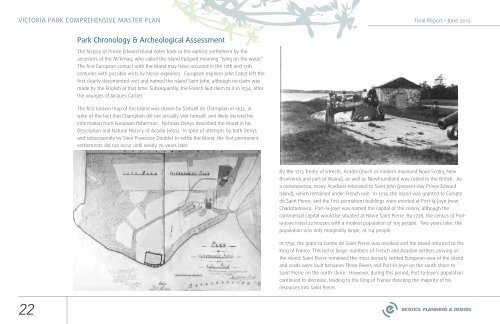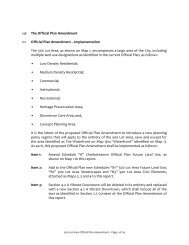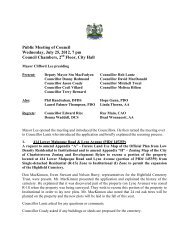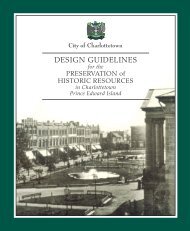Victoria_Park_Re port Final.pdf - City of Charlottetown
Victoria_Park_Re port Final.pdf - City of Charlottetown
Victoria_Park_Re port Final.pdf - City of Charlottetown
Create successful ePaper yourself
Turn your PDF publications into a flip-book with our unique Google optimized e-Paper software.
VICTORIA PARK COMPREHENSIVE MASTER PLAN<br />
<strong>Final</strong> <strong>Re</strong><strong>port</strong> • June 2013<br />
<strong>Park</strong> Chronology & Archeological Assessment<br />
The history <strong>of</strong> Prince Edward Island dates back to the earliest settlement by the<br />
ancestors <strong>of</strong> the Mi’kmaq, who called the Island Epāgwĭt meaning “lying on the water”.<br />
The first European contact with the Island may have occurred in the 12th and 13th<br />
centuries with possible visits by Norse explorers. European explorer John Cabot left the<br />
first clearly documented visit and named the island Saint John, although no claim was<br />
made by the English at that time. Subsequently, the French laid claim to it in 1534, after<br />
the voyages <strong>of</strong> Jacques Cartier.<br />
The first known map <strong>of</strong> the Island was drawn by Samuel de Champlain in 1632, in<br />
spite <strong>of</strong> the fact that Champlain did not actually visit himself, and likely derived his<br />
information from European fisherman. Nicholas Denys described the Island in his<br />
Description and Natural History <strong>of</strong> Acadia (1672). In spite <strong>of</strong> attempts by both Denys<br />
and subsequently by Sieur Francoise Doublet to settle the Island, the first permanent<br />
settlements did not occur until nearly 70 years later.<br />
By the 1713 Treaty <strong>of</strong> Utrecht, Acadia (much <strong>of</strong> modern mainland Nova Scotia, New<br />
Brunswick and part <strong>of</strong> Maine), as well as Newfoundland was ceded to the British. As<br />
a consequence, many Acadians relocated to Saint John (present-day Prince Edward<br />
Island), which remained under French rule. In 1719, the Island was granted to Compte<br />
de Saint Pierre, and the first permanent buildings were erected at Port-la-Joye (now<br />
<strong>Charlottetown</strong>). Port-la-Joye was named the capital <strong>of</strong> the colony, although the<br />
commercial capital would be situated at Havre Saint Pierre. By 1728, the census <strong>of</strong> Portla-Joye<br />
listed 22 houses with a modest population <strong>of</strong> 105 people. Two years later, the<br />
population was only marginally larger, at 114 people.<br />
In 1730, the grant to Comte de Saint Pierre was revoked and the Island returned to the<br />
King <strong>of</strong> France. This led to larger numbers <strong>of</strong> French and Acadian settlers arriving on<br />
the island. Saint Pierre remained the most densely settled European area <strong>of</strong> the island<br />
and roads were built between Three Rivers and Port-la-Joye on the south shore to<br />
Saint Pierre on the north shore. However, during this period, Port-la-Joye’s population<br />
continued to decrease, leading to the King <strong>of</strong> France directing the majority <strong>of</strong> his<br />
resources into Saint Pierre.<br />
22
















